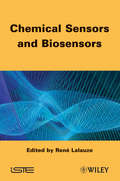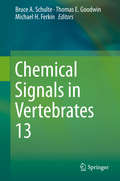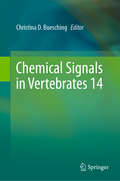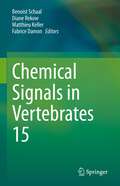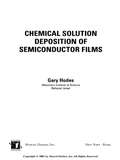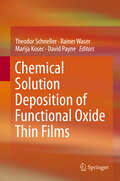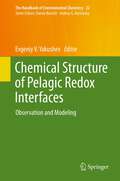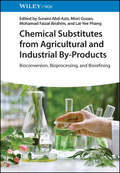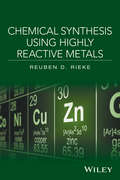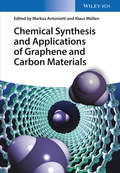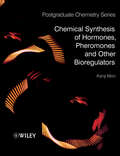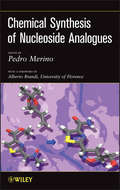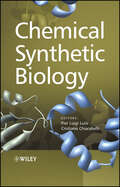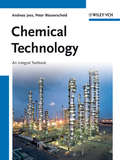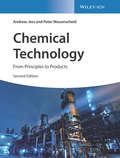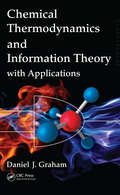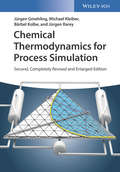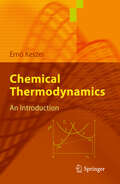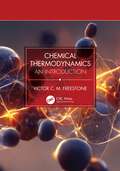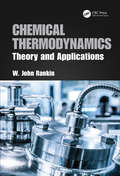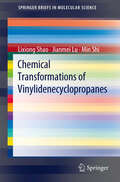- Table View
- List View
Chemical Sensors and Biosensors
by René LalauzeTechnological needs for chemical, ionic and biological species detection are giving rise to continuous research and development in physico-chemistry and biology. The constant progress being made in the theoretical and technological aspects concerning studies and developments of chemical sensors, biosensors and biochips is presented in this book by different scientists and professors from different universities and constitutes an updating of the state of the art for chemical sensors, biosensors and biochips. This book places a large emphasis on interaction between chemical and biological species, in a gaseous or liquid state, and details mineral and biological materials acting as sensitive elements. The role of electrical, electrochemical, piezoelectric and optical transducers in detection mechanisms are presented through their developments and from a performance point-of-view. Micro-reactors, nanotechnologies and flexible substrates, are considered in relation to their role in neural networks. Contents 1. Chemical and Biological Recognition, Nicole Jaffrezic-Renault. 2. Adsorption Phenomena, René Lalauze. 3. Microcantilever Transduction, Isabelle Dufour. 4. Piezoelectric Transduction (QCM), Hubert Perrot. 5. Metal Oxide Gas Sensors, Christophe Pijolat. 6. Molecular Material-based Conductimetric Gas Sensors, Marcel Bouvet. 7. Responses and Electrical Properties of Gas Microsensors, Khalifa Aguir. 8. Gas Microsensor Technology, Philippe Menini. 9. Multisensors: Measurements and Behavior Models, Philippe Breuil. 10. Development of Microtechnologies for the Realization of Chemical, Biochemical and/or Biological Microsensors, Pierre Temple-Boyer. 11. Development of Micro-preconcentrators for the Detection of Gaseous Species at Trace Level, Jean-Paul Viricelle. 12. Microfluidics: Manipulation of Nanovolume Samples, Louis Renaud. 13. Electrochemical Biosensors, Chantal Gondran. 14. Fiber-optic Biosensors, Neso Sojic. 15. In Vivo Analyses with Electrochemical Microsensors, Stéphane Arbault. 16. Microbial Biosensors for Environmental Applications, Gérald Thouand and Marie José Durand. 17. Biofuel Cells, Serge Cosnier.
Chemical Signals in Vertebrates 12
by Martin Dehnhard Marion L EastThree invited international experts present overviews of recent developments in key fields and will submit chapters for the book. Jane Hurst from Liverpool University in the UK presents an overview on the function, mechanisms and evolution of chemical signals, Penelope Hawkins from the University of Western Australia will detail the importance of male odors in female mate-choice and the priming of female reproduction, and Francesco Bonadonna from CNRS-CEFE, Montpellier in France presents an overview of the importance of chemical signals for the formation and maintenance of pair-bonds, parent - offspring recognition and navigation in seabirds. Select submissions are invited by the scientific committee to contribute chapters.
Chemical Signals in Vertebrates 13
by Bruce A. Schulte Thomas E. Goodwin Michael H. FerkinIn 2014, the Chemical Signals in Vertebrates (CSiV) group held its 13th triennial meeting in conjunction with the 30th meeting of the International Society of Chemical Ecology (ISCE). The meeting convened on the campus of the University of Illinois at Urbana-Champaign. This meeting was the first held jointly with these two groups, which share common history and are dedicated to understanding the role of chemical communication in the lives of organisms. This volume is a collection of the proceedings of this meeting and, like the meeting, cover a variety of topics in chemical ecology, including Chemical Ecology of Social Behavi∨ Chemical Signals - Analysis and Synthesis; Evolution, Genomics, and Transcriptomics of Chemical Signals; Molecular Mechanisms of Semiochemical Perception and Processing; Multimodal Communication; and Neuroethology and Neurophysiology.
Chemical Signals in Vertebrates 14
by Christina D. BueschingIn August 2017, the Chemical Signals in Vertebrates (CSiV) group held its 14th triennial meeting at Cardiff University in Wales. This well established international conference brings together leaders and students in the field of olfactory communication and chemical signaling of vertebrates to present new advances in their research as well as synopses of disparate areas under new angles. This volume is a collection of the proceedings of this meeting authored by leading experts in this field that covers a wide variety of topics in chemical ecology.
Chemical Signals in Vertebrates 15
by Benoist Schaal Diane Rekow Matthieu Keller Fabrice DamonThe 15th Meeting on Chemical Signals in Vertebrates (CSiV) reunited participants from 20 countries from 5 continents who "electronically commuted" to Dijon, France, during three days (3-5 November 2021). This virtual meeting was a great opportunity to share information on how amphibians, reptiles, birds, and mammals communicate through chemosignals and integrate their environment through chemical cues. Scientists from varied disciplines ranging from biology and psychology to chemistry and biostatistics attended the meeting to share their research on how vertebrates produce and release chemical cues and signals, how they detect, discriminate, process, and interpret them; how they respond to them behaviorally, physiologically, and/or neurally in adaptive ways; how the typical or atypical environment modulates such chemocommunication loops, and chemoreception in general. In total, this 2021 CSiV meeting presented important new findings, representative of the growing points in the rapidly expanding field of research on chemocommunication among vertebrates. As appreciated by D Müller-Schwarze (a well-known pioneer in the field and the founding father of the book series in question) in his foreword to the meeting, “Our field has broadened to new horizons: besides multicomponent cues, we now learn about multisource and multifunction chemical signals. The range of study animals and settings has become richer, and we have learned enough that practical applications are becoming realistic.” This proceedings documents key presentations from this virtual conference.
Chemical Solution Deposition Of Semiconductor Films
by Gary HodesDiscussing specific depositions of a wide range of semiconductors and properties of the resulting films, Chemical Solution Deposition of Semiconductor Films examines the processes involved and explains the effect of various process parameters on final film and film deposition outcomes through the use of detailed examples. Supplying experimental results and practical examples, the book covers fundamental scientific principles underlying the chemical deposition process, various mechanisms involved in deposition, films of all the semiconductors deposited by this technique, and the use of semiconductor films in photovoltaics, photoelectrochemical properties, and size quantization effects.
Chemical Solution Deposition of Functional Oxide Thin Films
by David Payne Rainer Waser Theodor Schneller Marija KosecThis is the first text to cover all aspects of solution processed functional oxide thin-films. Chemical Solution Deposition (CSD) comprises all solution based thin- film deposition techniques, which involve chemical reactions of precursors during the formation of the oxide films, i. e. sol-gel type routes, metallo-organic decomposition routes, hybrid routes, etc. While the development of sol-gel type processes for optical coatings on glass by silicon dioxide and titanium dioxide dates from the mid-20th century, the first CSD derived electronic oxide thin films, such as lead zirconate titanate, were prepared in the 1980's. Since then CSD has emerged as a highly flexible and cost-effective technique for the fabrication of a very wide variety of functional oxide thin films. Application areas include, for example, integrated dielectric capacitors, ferroelectric random access memories, pyroelectric infrared detectors, piezoelectric micro-electromechanical systems, antireflective coatings, optical filters, conducting-, transparent conducting-, and superconducting layers, luminescent coatings, gas sensors, thin film solid-oxide fuel cells, and photoelectrocatalytic solar cells. In the appendix detailed "cooking recipes" for selected material systems are offered.
Chemical Structure of Pelagic Redox Interfaces: Observation and Modeling (The Handbook of Environmental Chemistry #22)
by Evgeniy V. YakushevOver the last few decades many studies have focused on the oxygen depletion of coastal and oceanic waters. An understanding of the processes involved is fundamental to assess the effects of global and climatic changes and to support an ecosystem approach to adaptive environmental management for coastal seas and ocean basins. This timely book presents the state-of-the-art of our knowledge of the nature and chemical structure of redox interfaces in a marine water column, oxygen depletion and connected processes. The structures of the redox layers, including the distribution of certain parameters and microbiological features, are described in detail. The volume also covers studies devoted to the interannual variability of some oxygen-depleted systems, modeling and new developments in observation techniques. In addition, it identifies remaining gaps in our knowledge of the cycling of chemical elements in changing redox conditions. The chapters are based on extensive observational data, collected by the authors during sea and shore expeditions, on archive data, and on a broad range of scientific literature.
Chemical Substitutes from Agricultural and Industrial By-Products: Bioconversion, Bioprocessing, and Biorefining
by Suraini Abd-Aziz; Misri Gozan; Mohamad Faizal Ibrahim; Lai-Yee PhangChemical Substitutes from Agricultural and Industrial By-Products A comprehensive resource presenting different manufacturing bioprocesses of chemical substitutes, from agricultural and industrial by-products to value-added biorefinery products Chemical Substitutes from Agricultural and Industrial By-Products: Bioconversion, Bioprocessing, and Biorefining discusses the biorefinery of chemical substitutes from agricultural and industrial by-products, covering the consolidated bioconversion, bioprocessing, and downstream process of the significant chemical substitutes produced. In each chapter, the individual aspects of bioconversion, bioprocessing, and downstream process of chemical substitutes produced from selected agricultural and industrial by-products to selected chemical substitutes are discussed. The text includes helpful case studies of specific processes to aid in reader comprehension. Edited by four highly qualified academics, Chemical Substitutes from Agricultural and Industrial By-Products: Bioconversion, Bioprocessing, and Biorefining includes information on: Common substitutes for chemicals obtained from biomass of agricultural wastes and industrial by-products, including antioxidants, oleoresin, nanocarbon materials, enzymes, essential oils, bio-bleaching agents, and biosugars Alternative substitutes, including biofertilizers, cocoa butter substitutes, bio-succinic acids, furfural derivatives, levulinic acids, and cellulases Economic calculations, such as cost analysis, of different bioprocesses to analyze their feasibility in business and general industry Environmental impact analysis of chemical substitutes from agricultural and industrial by-products for a sustainable agriculture system Enabling readers to create a change in the perception of the waste agricultural biomass from waste to resource, Chemical Substitutes from Agricultural and Industrial By-Products: Bioconversion, Bioprocessing, and Biorefining is an essential resource for biotechnologists, chemists in industry, natural products chemists, process engineers, chemical engineers, and environmental chemists.
Chemical Synthesis Using Highly Reactive Metals
by Reuben D. RiekeWritten by the creator of Rieke metals, valuable for chemical reaction methods and efficiency, this groundbreaking book addresses a significant aspect of organic and inorganic chemistry. The author discusses synthetic methods, preparation procedures, chemical reactions, and applications for highly reactive metals and organometallic reagents.• Addresses a new generation of chemistry that goes beyond the standard use of metals and activation• Provides step-by-step guidelines, chemical equations, and experimental descriptions for handling metals including zinc, magnesium, copper, indium, nickel, manganese, calcium, barium, iron, palladium, platinum, uranium, thorium, aluminum, cobalt, and chromium• Uses a unique approach to highlight methods and techniques that make chemical synthesis and activation of Rieke metals more safe and efficient• Discusses novel applications and special topics, such as highly reactive metals for novel organometallic reagents, semiconducting polymers, plastics electronics, photovoltaics, and the Reformatsky reagent
Chemical Synthesis and Applications of Graphene and Carbon Materials
by Klaus Müllen Markus AntoniettiThis ready reference and handbook is unique in its focus on synthesis and the application of graphene and other carbon materials with an emphasis on chemistry aspects. To this extent, it deals with top-down and bottom-up approaches across the different length scales for graphene from polycyclic aromatic hydrocarbons to graphene nanoribbons and graphene sheets, as well as carbon materials from quantum dots, nanostructured particles, and fibers, right up to tubes, bulk structures, and much more besides. In so doing, it presents the best synthetic methods: pyrolysis, chemical vapor deposition, templating and surface-mediated synthesis, self-assembly, surface-grafting and modification. Edited by two excellent, experienced and highly renowned editors, both of whom are directors of Max Planck Institutes.
Chemical Synthesis of Hormones, Pheromones and Other Bioregulators
by Kenji MoriMany small molecules occur naturally as "messenger" chemicals which regulate the behaviour and functions of microbes, plants, insects and animals. Examples include hormones, pheromones, phytoalexins, and antifeedants. These biofunctional molecules are of great interest to researchers in helping develop our understanding of biological function and in the development of new drugs. However extracting them from nature can be prohibitively expensive, so there is great interest in devising methods of synthesising them from simple starting materials in the laboratory.Chemical Synthesis of Hormones, Pheromones and Other Bioregulators is an introduction to the techniques and strategies for the synthesis of biofunctional small molecules. Topics include:what are biofunctional molecules?why must biofunctional molecules be synthesized?how can we synthesize biofunctional molecules?the synthesis of phytohormones, phytoalexins and other biofunctional molecules of plant originthe synthesis of insect juvenile hormones and antifeedantsthe synthesis of pheromones and the significance of chirality in pheromone sciencethe synthesis of microbial hormones and pheromones, antibiotics, and other biofunctional molecules of microbial originthe synthesis of marine antifeedants and medicinal candidatesa synthetic examination of incorrectly proposed structures of biomoleculesreflections on science as a human endeavorDrawing on a career of almost 50 years researching and teaching this subject, Kenji Mori's Chemical Synthesis of Hormones, Pheromones and Other Bioregulators is a must-have textbook for students and researchers of organic synthesis and natural products, and a stimulating and inspiring account of a distinguished chemical career.
Chemical Synthesis of Nucleoside Analogues
by Pedro MerinoCompiles current tested and proven approaches to synthesize novel nucleoside analogues Featuring contributions from leading synthetic chemists from around the world, this book brings together and describes tested and proven approaches for the chemical synthesis of common families of nucleoside analogues. Readers will learn to create new nucleoside analogues with desired therapeutic properties by using a variety of methods to chemically modify natural nucleosides, including:Changes to the heterocyclic baseModification of substituents at the sugar ringReplacement of the furanose ring by a different carbo- or heterocyclic ringIntroduction of conformational restrictionsSynthesis of enantiomersPreparation of hydrolitically stable C-nucleosidesChemical Synthesis of Nucleoside Analogues covers all the major classes of nucleosides, including pronucleotides, C-nucleosides, carbanucleosides, and PNA monomers which have shown great promise as starting points for the synthesis of nucleoside analogues. The book also includes experimental procedures for key reactions related to the synthesis of nucleoside analogues, providing a valuable tool for the preparation of a number of different compounds.Throughout the book, chemical schemes and figures help readers better understand the chemical structures of nucleoside analogues and the methods used to synthesize them. Extensive references serve as a gateway to the growing body of original research studies and reviews in the field.Synthetically modified nucleosides have proven their value as therapeutic drugs, in particular as antiviral and antitumor agents. However, many of these nucleoside analogues have undesirable side effects. With Chemical Synthesis of Nucleoside Analogues as their guide, researchers have a new tool for synthesizing a new generation of nucleoside analogues that can be used as therapeutic drugs with fewer unwanted side effects.
Chemical Synthetic Biology
by Pier Luigi Luisi Cristiano ChiarabelliChemistry plays a very important role in the emerging field of synthetic biology. In particular, chemical synthetic biology is concerned with the synthesis of chemical structures, such as proteins, that do not exist in nature. With contributions from leading international experts, Chemical Synthetic Biology shows how chemistry underpins synthetic biology. The book is an essential guide to this fascinating new field, and will find a place on the bookshelves of researchers and students working in synthetic chemistry, synthetic and molecular biology, bioengineering, systems biology, computational genomics, and bioinformatics.
Chemical Technology
by Andreas Jess Peter WasserscheidThis textbook provides an integral and integrated treatment of industrial-relevant problems for students of both chemistry and chemical engineering.As such, this work combines the four disciplines of chemical technology - chemistry, thermal and mechanical unit operations, chemical reaction engineering and general chemical technology - and is organized into two main parts. The first covers the fundamentals, as well as the analysis and design of industrial processes, while the second section presents 20 concrete processes, exemplifying the inherent applied nature of chemical technology. These are selected so that they all differ with respect to at least one important aspect, such as the type and design of the reactor, the chemistry involved or the separation process used. As a result, readers will recapitulate, deepen and exercise the chemical and engineering principles and their interplay, as well as being able to apply them to industrial practice.Instructive figures, rules of thumb for swift but reliable estimating of parameters, data of chemical media, and examples utilizing data from industrial processes facilitate and enhance the study process. A small general survey of selected modern trends, such as multifunctional and micro reactors, or new solvents for homogeneous catalysis, such as ionic liquids, point out to the reader that this is not a concluded discipline, but a developing field with many challenges waiting to be solved.From the reviews:"This is an excellent book. The authors have set themselves a daunting task: combining in one volume the basics of industrial chemistry, physical chemistry, catalysis, and chemical engineering. The result is a highly readable and useful textbook that covers all the fundamental aspects of technical chemistry and fits well with today's curricula... There are several other good textbooks that target one or more of the specific subjects..., but this is the first well written and clearly presented comprehensive textbook on modern chemical technology. In summary, this book is timely, useful, well thought out and well presented. It contains lots of useful knowledge. I highly recommend it to teachers of chemical technology, to senior undergraduates and graduate students in chemistry who are interested in the industrial aspects of their profession, and of course to chemical engineers." -Angewandte Chemie, Int. Ed. 2013
Chemical Technology: An Integral Textbook
by Andreas Jess Peter WasserscheidThis textbook provides an integral and integrated treatment of industrial-relevant problems for students of both chemistry and chemical engineering. As such, this work combines the four disciplines of chemical technology - chemistry, thermal and mechanical unit operations, chemical reaction engineering and general chemical technology - and is organized into two main parts. The first covers the fundamentals, as well as the analysis and design of industrial processes, while the second section presents 20 concrete processes, exemplifying the inherent applied nature of chemical technology. These are selected so that they all differ with respect to at least one important aspect, such as the type and design of the reactor, the chemistry involved or the separation process used. As a result, readers will recapitulate, deepen and exercise the chemical and engineering principles and their interplay, as well as being able to apply them to industrial practice. Instructive figures, rules of thumb for swift but reliable estimating of parameters, data of chemical media, and examples utilizing data from industrial processes facilitate and enhance the study process. A small general survey of selected modern trends, such as multifunctional and micro reactors, or new solvents for homogeneous catalysis, such as ionic liquids, point out to the reader that this is not a concluded discipline, but a developing field with many challenges waiting to be solved.
Chemical Technology: From Principles to Products (Coursesmart Ser.)
by Andreas Jess Peter WasserscheidA fully updated edition of a popular textbook covering the four disciplines of chemical technology?featuring new developments in the field Clear and thorough throughout, this textbook covers the major sub-disciplines of modern chemical technology?chemistry, thermal and mechanical unit operations, chemical reaction engineering, and general chemical technology?alongside raw materials, energy sources and detailed descriptions of 24 important industrial processes and products. It brings information on energy and raw material consumption and production data of chemicals up to date and offers not just improved and extended chapters, but completely new ones as well. This new edition of Chemical Technology: From Principles to Products features a new chapter illustrating the global economic map and its development from the 15th century until today, and another on energy consumption in human history. Chemical key technologies for a future sustainable energy system such as power-to-X and hydrogen storage are now also examined. Chapters on inorganic products, material reserves, and water consumption and resources have been extended, while another presents environmental aspects of plastic pollution and handling of plastic waste. The book also adds four important processes to its pages: production of titanium dioxide, silicon, production and chemical recycling of polytetrafluoroethylene, and fermentative synthesis of amino acids. -Provides comprehensive coverage of chemical technology?from the fundamentals to 24 of the most important processes -Intertwines the four disciplines of chemical technology: chemistry, thermal and mechanical unit operations, chemical reaction engineering and general chemical technology -Fully updated with new content on: power-to-X and hydrogen storage; inorganic products, including metals, glass, and ceramics; water consumption and pollution; and additional industrial processes -Written by authors with extensive experience in teaching the topic and helping students understand the complex concepts Chemical Technology: From Principles to Products, Second Edition is an ideal textbook for advanced students of chemical technology and will appeal to anyone in chemical engineering.
Chemical Thermodynamics and Information Theory with Applications
by Daniel J. GrahamThermodynamics and information touch theory every facet of chemistry. However, the physical chemistry curriculum digested by students worldwide is still heavily skewed toward heat/work principles established more than a century ago. Rectifying this situation, Chemical Thermodynamics and Information Theory with Applications explores applications dra
Chemical Thermodynamics for Process Simulation
by Jürgen Gmehling Michael Kleiber Bärbel Kolbe Jürgen RareyThe only textbook that applies thermodynamics to real-world process engineering problems This must-read for advanced students and professionals alike is the first book to demonstrate how chemical thermodynamics work in the real world by applying them to actual engineering examples. It also discusses the advantages and disadvantages of the particular models and procedures, and explains the most important models that are applied in process industry. All the topics are illustrated with examples that are closely related to practical process simulation problems. At the end of each chapter, additional calculation examples are given to enable readers to extend their comprehension. Chemical Thermodynamics for Process Simulation instructs on the behavior of fluids for pure fluids, describing the main types of equations of state and their abilities. It discusses the various quantities of interest in process simulation, their correlation, and prediction in detail. Chapters look at the important terms for the description of the thermodynamics of mixtures; the most important models and routes for phase equilibrium calculation; models which are applicable to a wide variety of non-electrolyte systems; membrane processes; polymer thermodynamics; enthalpy of reaction; chemical equilibria, and more. -Explains thermodynamic fundamentals used in process simulation with solved examples -Includes new chapters about modern measurement techniques, retrograde condensation, and simultaneous description of chemical equilibrium -Comprises numerous solved examples, which simplify the understanding of the often complex calculation procedures, and discusses advantages and disadvantages of models and procedures -Includes estimation methods for thermophysical properties and phase equilibria thermodynamics of alternative separation processes -Supplemented with MathCAD-sheets and DDBST programs for readers to reproduce the examples Chemical Thermodynamics for Process Simulation is an ideal resource for those working in the fields of process development, process synthesis, or process optimization, and an excellent book for students in the engineering sciences.
Chemical Thermodynamics for Process Simulation
by Jürgen Gmehling Michael Kleiber Bärbel Kolbe Jürgen RareyThe only textbook that applies thermodynamics to real-world process engineering problems This must-read for advanced students and professionals alike is the first book to demonstrate how chemical thermodynamics work in the real world by applying them to actual engineering examples. It also discusses the advantages and disadvantages of the particular models and procedures, and explains the most important models that are applied in process industry. All the topics are illustrated with examples that are closely related to practical process simulation problems. At the end of each chapter, additional calculation examples are given to enable readers to extend their comprehension. Chemical Thermodynamics for Process Simulation instructs on the behavior of fluids for pure fluids, describing the main types of equations of state and their abilities. It discusses the various quantities of interest in process simulation, their correlation, and prediction in detail. Chapters look at the important terms for the description of the thermodynamics of mixtures; the most important models and routes for phase equilibrium calculation; models which are applicable to a wide variety of non-electrolyte systems; membrane processes; polymer thermodynamics; enthalpy of reaction; chemical equilibria, and more. -Explains thermodynamic fundamentals used in process simulation with solved examples -Includes new chapters about modern measurement techniques, retrograde condensation, and simultaneous description of chemical equilibrium -Comprises numerous solved examples, which simplify the understanding of the often complex calculation procedures, and discusses advantages and disadvantages of models and procedures -Includes estimation methods for thermophysical properties and phase equilibria thermodynamics of alternative separation processes -Supplemented with MathCAD-sheets and DDBST programs for readers to reproduce the examples Chemical Thermodynamics for Process Simulation is an ideal resource for those working in the fields of process development, process synthesis, or process optimization, and an excellent book for students in the engineering sciences.
Chemical Thermodynamics in Materials Science: From Basics to Practical Applications
by Taishi Matsushita Kusuhiro MukaiThis textbook covers chemical thermodynamics in materials science from basic to advanced level, especially for iron and steel making processes.To improve a process by applying knowledge of thermodynamics or to assess the calculation results of thermodynamic software, an accurate and systematic understanding of thermodynamics is required. For that purpose, books from which one can learn thermodynamics from the basic to the advanced level are needed, but such books are rarely published. This book bridges the gap between the basics, which are treated in general thermodynamic books, and their application, which are only partially dealt with in most specialized books on a specific field.This textbook can be used to teach the basics of chemical thermodynamics and its applications to beginners. The basic part of the book is written to help learners acquire robust applied skills in an easy-to-understand manner, with in-depth explanations and schematic diagrams included. The same book can be used by advanced learners as well. Those higher-level readers such as post-graduate students and researchers may refer to the basic part of the book to get down to the basic concepts of chemical thermodynamics or to confirm the basic concepts. Abundant pages are also devoted to applications designed to present more advanced applied skills grounded in a deep understanding of the basics. The book contains some 50 examples and their solutions so that readers can learn through self-study.
Chemical Thermodynamics: An Introduction
by Ernö KeszeiThis course-derived undergraduate textbook provides a concise explanation of the key concepts and calculations of chemical thermodynamics. Instead of the usual 'classical' introduction, this text adopts a straightforward postulatory approach that introduces thermodynamic potentials such as entropy and energy more directly and transparently. Structured around several features to assist students' understanding, Chemical Thermodynamics : Develops applications and methods for the ready treatment of equilibria on a sound quantitative basis.Requires minimal background in calculus to understand the text and presents formal derivations to the student in a detailed but understandable way.Offers end-of-chapter problems (and answers) for self-testing and review and reinforcement, of use for self- or group study.This book is suitable as essential reading for courses in a bachelor and master chemistry program and is also valuable as a reference or textbook for students of physics, biochemistry and materials science.
Chemical Thermodynamics: An Introduction
by Victor CM FreestoneThermodynamics can never be made easy, but with the right approach and a consistent use of scientific terms it can be made less opaque, and it can give a person, who is prepared to try, an insight into how science explains why things happen the way they do. The approach adopted in this book will give readers a better understanding of how science works together with its limitations. Unfortunately, thermodynamics, or at least some parts of it, is a subject which (apart from quantum mechanics) probably causes most confusion and bewilderment amongst scientists. The majority of students do not understand or “get” thermodynamics, and it is considered a “hard” or difficult subject. There are multiple reasons for this. There is of course mathematics, and many thermodynamic texts appear to be lists upon lists of differential equations. Another reason is that thermodynamics is, as often as not, poorly taught by teachers/lecturers who themselves do not understand, or appreciate, or have any interest in the subject (often all three). This results not only in a lack of scientific rigorousness in the teaching of the subject with the resulting confusion, and sometimes teachers, lecturers and authors just get it plain wrong (this occurs surprisingly often). However, it need not be like this and although mathematics (including calculus) is required, it can be kept to a relatively elementary level in order to obtain an understanding of this most important of subjects. No one can pretend that the subject is easy, but it can be made more accessible by a rigorous definition of terms and concepts and ensuring that a consistency of use of these definitions is maintained.Highlighting the benefits of thermodynamics in practical science, the text gives an intuitive grasp of the major concepts of thermodynamics such as energy and entropy. Provides a new pedagogic approach to understanding and teaching chemical thermodynamics. Starting with a set of basic simple assumptions about what constitutes topics such as an ideal gas, theories are developed in a clear, concise and accessible manner that will either answer or at the very least give an insight into a surprising range of scientific phenomena including energy, heat, temperature, properties of gases, time and quantum theory. Assumes that the reader has essentially no knowledge of the subject. Mathematics (including calculus) is kept to a relatively elementary level in order to obtain an understanding of this most important of subjects. Provides the reader with a better understanding of how science works together with its limitations.
Chemical Thermodynamics: Theory and Applications
by W.J. RankinThis book develops the theory of chemical thermodynamics from first principles, demonstrates its relevance across scientific and engineering disciplines, and shows how thermodynamics can be used as a practical tool for understanding natural phenomena and developing and improving technologies and products. Concepts such as internal energy, enthalpy, entropy, and Gibbs energy are explained using ideas and experiences familiar to students, and realistic examples are given so the usefulness and pervasiveness of thermodynamics becomes apparent. The worked examples illustrate key ideas and demonstrate important types of calculations, and the problems at the end of chapters are designed to reinforce important concepts and show the broad range of applications. Most can be solved using digitized data from open access databases and a spreadsheet. Answers are provided for the numerical problems. A particular theme of the book is the calculation of the equilibrium composition of systems, both reactive and non-reactive, and this includes the principles of Gibbs energy minimization. The overall approach leads to the intelligent use of thermodynamic software packages but, while these are discussed and their use demonstrated, they are not the focus of the book, the aim being to provide the necessary foundations. Another unique aspect is the inclusion of three applications chapters: heat and energy aspects of processing; the thermodynamics of metal production and recycling; and applications of electrochemistry. This book is aimed primarily at students of chemistry, chemical engineering, applied science, materials science, and metallurgy, though it will be also useful for students undertaking courses in geology and environmental science. A solutions manual is available for instructors.
Chemical Transformations of Vinylidenecyclopropanes (SpringerBriefs in Molecular Science)
by Min Shi Jianmei Lu Lixiong ShaoModern organic synthesis has paid much attention to the chemistry of small carbocycles. Vinylidenecyclopropanes (VDCPs), which have strained cyclopropyl group connected with an allene moiety and yet are thermally stable and reactive substances in organic chemistry, are versatile intermediates in organic synthesis. In this volume, Dr. Lixiong Shao, Dr. Jianmei Lu and Prof. Dr. Min Shi review their investigations on the chemistry of VDCPs, mainly including the preparation, the reactivities upon treatment with Lewis or Brønsted acid, as well as transition metal catalysts and some other miscellaneous analogues. The contributions aroused a renaissance of cationic intermediates in the chemistry of VDCPs.
